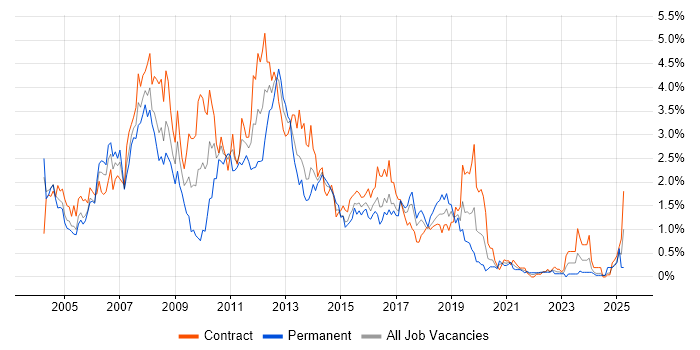IBM WebSphere
Scotland > Glasgow
The table below provides summary statistics and contractor rates for jobs advertised in Glasgow requiring WebSphere skills. It covers contract job vacancies from the 6 months leading up to 1 December 2025, with comparisons to the same periods in the previous two years.
| 6 months to 1 Dec 2025 |
Same period 2024 | Same period 2023 | |
|---|---|---|---|
| Rank | - | - | 71 |
| Rank change year-on-year | - | - | +10 |
| Contract jobs citing WebSphere | 0 | 0 | 8 |
| As % of all contract jobs in Glasgow | - | - | 0.91% |
| As % of the Application Platforms category | - | - | 6.90% |
| Number of daily rates quoted | 0 | 0 | 6 |
| 10th Percentile | - | - | £380 |
| 25th Percentile | - | - | £417 |
| Median daily rate (50th Percentile) | - | - | £441 |
| Median % change year-on-year | - | - | -27.70% |
| 75th Percentile | - | - | £442 |
| 90th Percentile | - | - | £452 |
| Scotland median daily rate | £600 | - | £442 |
| % change year-on-year | - | - | -27.54% |
All Application Platform Skills
Glasgow
WebSphere falls under the Application Platforms category. For comparison with the information above, the following table provides summary statistics for all contract job vacancies requiring application platform skills in Glasgow.
| Contract vacancies with a requirement for application platform skills | 81 | 142 | 116 |
| As % of all contract IT jobs advertised in Glasgow | 10.73% | 19.24% | 13.21% |
| Number of daily rates quoted | 51 | 80 | 66 |
| 10th Percentile | £275 | £250 | £403 |
| 25th Percentile | £352 | £356 | £458 |
| Median daily rate (50th Percentile) | £415 | £449 | £535 |
| Median % change year-on-year | -7.57% | -16.07% | +7.00% |
| 75th Percentile | £525 | £562 | £684 |
| 90th Percentile | £734 | £639 | £700 |
| Scotland median daily rate | £447 | £450 | £543 |
| % change year-on-year | -0.67% | -17.05% | +20.56% |
| Number of hourly rates quoted | 1 | 1 | 2 |
| 10th Percentile | - | - | - |
| 25th Percentile | £17.98 | £25.25 | - |
| Median hourly rate | £18.00 | £26.50 | £15.42 |
| Median % change year-on-year | -32.08% | +71.85% | - |
| 75th Percentile | £18.02 | £27.75 | - |
| 90th Percentile | - | - | - |
| Scotland median hourly rate | £37.75 | £23.50 | £17.72 |
| % change year-on-year | +60.64% | +32.62% | - |
WebSphere
Job Vacancy Trend in Glasgow
Historical trend showing the proportion of contract IT job postings citing WebSphere relative to all contract IT jobs advertised in Glasgow.

WebSphere
Daily Rate Trend in Glasgow
Contractor daily rate distribution trend for jobs in Glasgow citing WebSphere.

